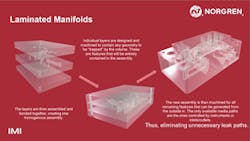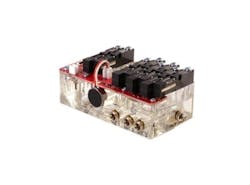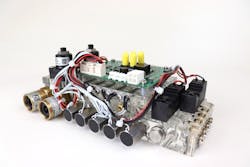OEMs often perform their own product development from start to finish, which can work well for areas in which they have expertise. In this way, OEMs might take advantage of prior designs by making minor adjustments for a next-generation product. Some of the challenges an in-house team might run into when designing fluidic control solutions include sourcing the right parts and materials needed, creating a high-performance functional design that meets their specifications, and developing an efficient production process. When an OEM requires components and assemblies outside their in-house expertise, or if their design team is overloaded, outsourcing can become a major productivity booster.
Outsourcing Benefits
Outsourcing all or part of the new product development process allows an OEM to focus on what they do best or have the manpower for, while leveraging the expertise of an outside source. This approach is particularly advantageous for small or specialized companies—particularly startups—that might have limited design resources in the first place. There is also value in outsourcing assemblies that are part of a larger system when you don’t have the engineering expertise in-house, which is often the case when designing customized fluidic devices.
When it comes to fluidic control device solutions, OEMs can quickly reduce their development time, while improving design performance, through selecting the proper outsourcing partner. For OEMs that suddenly find themselves in a time-to-market crunch, it’s important to note that outsourcing can be incorporated at any stage of a project without losing control of the process.
Working with a reputable engineering solutions provider offering custom-engineered fluidic control assemblies—with valves, air prep, and sensors integrated into one assembly—greatly reduces product assembly complexity and integration time for the OEM. The high design standards of an experienced team will produce a dimensionally stable fluid path with fewer connections and fewer potential leak points. In addition to optimizing the development process and performance by working with a fully integrated engineering and manufacturing partner, OEMs will reduce the ever-expanding supply chain risks that are afflicting many in-house operations. These benefits quickly translate into a reduction of unnecessary costs when working with the right partner.
Product Development Process and Solutions
As a well-respected fluidic solutions provider, Norgren's Precision Fluid OEM group specializes in supplying custom engineered fluid control solutions to a wide range of OEM companies, including those in the life sciences, food and beverage, agricultural, industrial process control, and transportation industries. Norgren boasts a host of unique engineering competencies as well as an integrated supply chain that allows the company to provide maximum value to its customers. Through the use of the right outsourcing company, OEMs are relieved of many of the transactions and monitoring of multiple vendors often necessary when designing a new assembly.
Norgren has created a functional process for producing quality fluidic solutions that is both valuable and efficient when dealing with its OEM partners. The first and most important step is information gathering, where both engineering teams merge to discuss the project, bringing their own expertise to the table. The OEM team brings the knowledge of their system and its needs while the Norgren engineering team brings years of experience with providing custom fluidic solutions to a broad number of industries. These teams will talk directly with each other to solidify an understanding of the customer’s application requirements.
Some of the information gathered will include the type of valves to be used; the media that will have to flow through the valves, such as air, water, or oil; valve flow coefficient (Cv); and other critical values such as pressure requirements, temperature ranges, and voltage ranges. Depending on the application, the assembly operation could be focused on pressure or flow, which can affect the final design.
Figure 2a
Figure 2b
Figure 2a and 2b: Multi-layer laminated manifolds provide the ability design complex geometries for specific application needs.
Having been in the business for so long, the company has become an expert with multi-layer polymer bonding technologies (see Figure 2a and 2b) that allow them to create integrated assemblies using a wide array of standard and custom components. For example, Norgren’s solenoid valve product range can deliver components operating from 0 to 1200 psig in a variety of series for everything from general purpose operations to special needs that might include material changes or medically compatible sanitary materials. Miniature valves are available as small as 6.5mm depending on your application requirements.
Once a full comprehension of the application needs is achieved, a functional schematic can be created. This allows the Norgren team to analyze and evaluate how a custom assembly might better serve the customer. By designing a custom manifold that incorporates multiple fluidic control components, the result is reduced footprint and weight, full component integration, reduced internal/dead volumes, consistent fluidic performance with fewer frictional losses, and fewer potential for leaks, all in a plug-and-play solution.
Those OEMs that choose to source system components from multiple suppliers add to the complexity and labor involved in product design as well as installation and maintenance. Ultimately, the engineering solutions provider’s goal is to deliver an assembly that provides the OEM with a single, drop-in place solution rather than multiple components that must be interconnected and wired individually (see Figure 3).
Figure 3: Multiple fluidic control components are built into a single drop-in solution with a small footprint and greater precision.
After the fluidic control assembly has been approved, the design goes through multiple validation procedures, including those provided through CFD (computational fluid dynamics) software analysis to tweak internal flow paths to make the final solution more linear. At this stage, it is also possible to provide magnetic analysis if a specially designed coil was included in the product. From here, a working prototype is produced and fully tested.
With twenty-two fully integrated global manufacturing facilities, Norgren is able to ensure quality, communication, and seamless integration of each assembly. This approach allows production to be easily scalable from low minimum order quantities to dedicated work cells, so production can grow as its OEM customer’s needs grow.
The company’s LEAN and ISO9001:2015 facilities manufacture subassemblies for long-lasting performance and serviceability. Every project is taken through a comprehensive process to ensure the final product meets the most demanding specifications through DFMEA (design failure mode and effect analysis), APQP (advanced product quality planning) process, first articles, and full production. Norgren also handles the most stringent manufacturing requirements leveraging its clean rooms, oxygen cleaning techniques, and its ability to meet and exceed a variety of regulatory compliance standards.
Conclusion
Employing integrated engineering solutions providers as part of your development team is a highly valuable business strategy. With an integrated solution OEMs can have just one source to go to, which simplifies design and manufacturing as well as installation, training, and maintenance of the system to ensures that the complex systems work properly and cohesively over time. Companies that employ this strategy not only have greater control over their production process but also are able to maintain higher quality standards. Integrated companies have control over their own scheduling and prioritizing, which allows them to provide accurate deliveries of completed assemblies while reducing costs and eliminating unnecessary design complexity for faster time-to-market scenarios.
For more information on Norgren and their products, please visit: https://www.norgren.com/.




